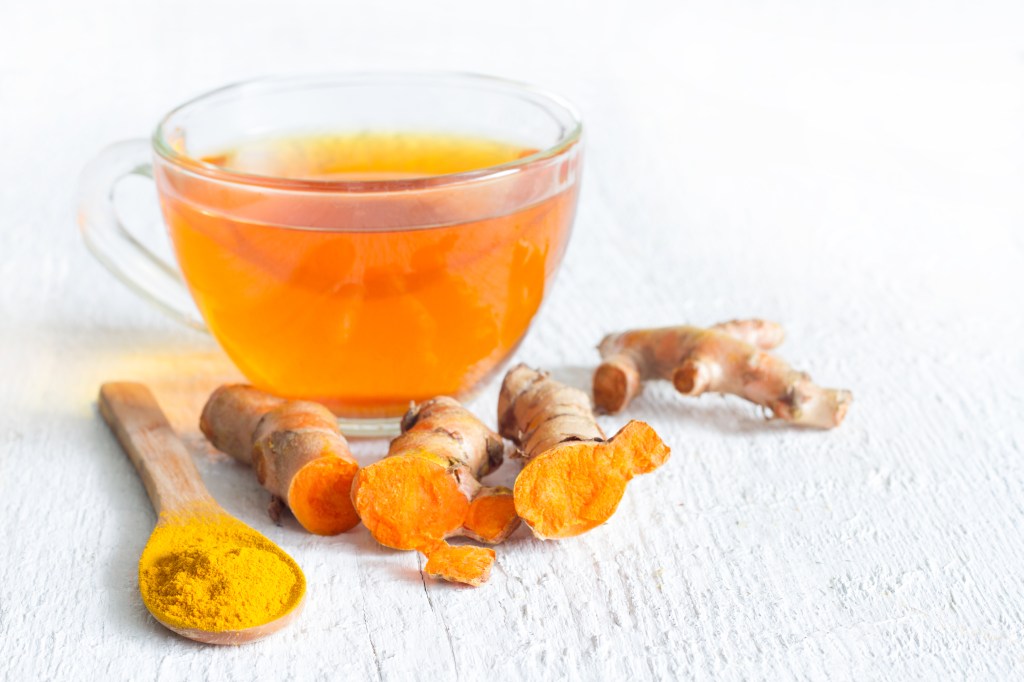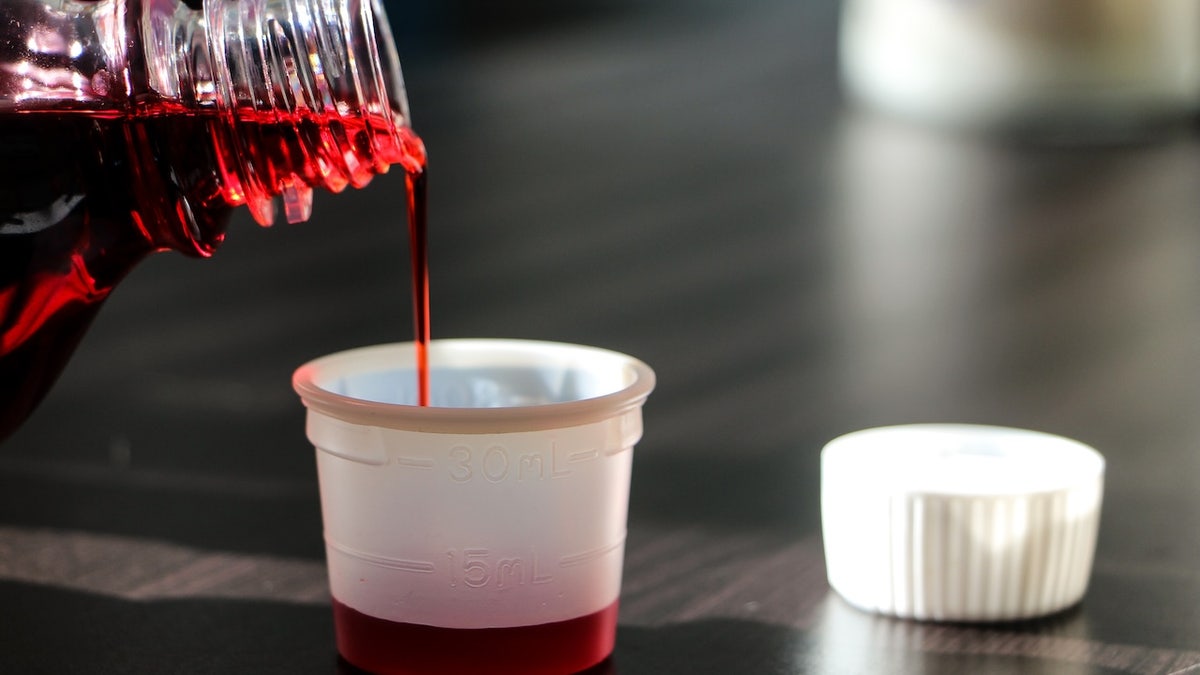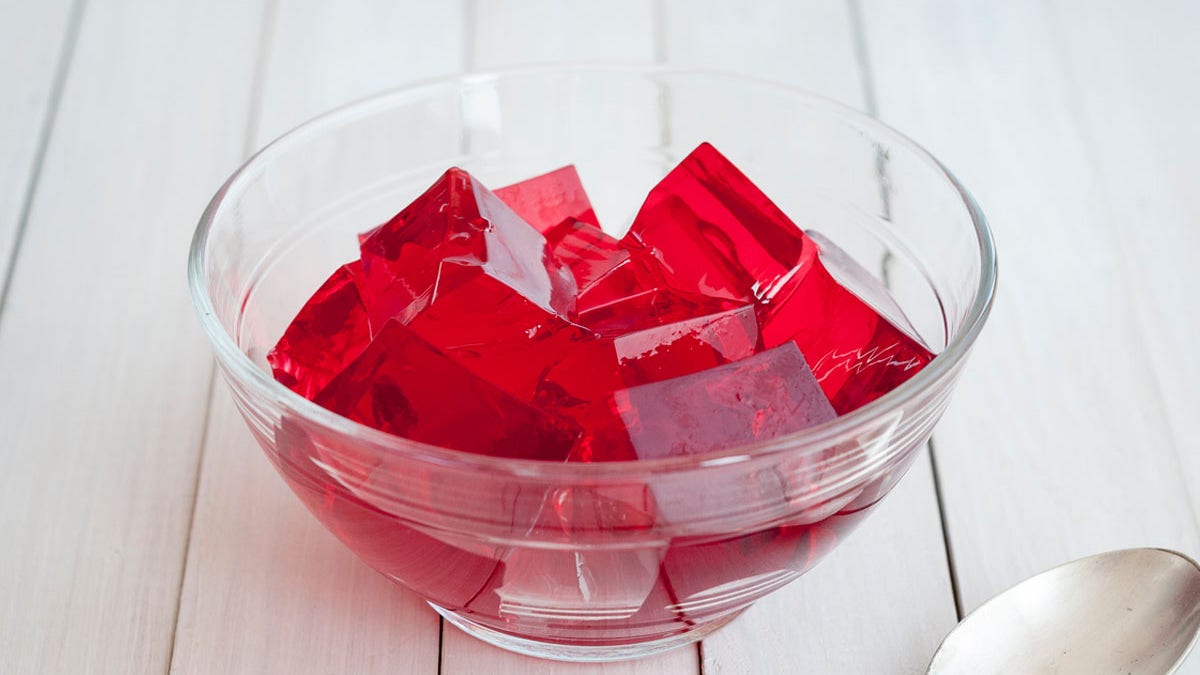Health
“Turmeric Tea Cured My Chronic Knee Pain — And Greatly Improved My Life!”

When it comes to natural anti-inflammatories, the golden-orange spice turmeric is a superstar. A relative of ginger, turmeric comes from the rhizome (root) of a native Asian plant that is mainly harvested in India. It’s dried, ground into a fine powder and used to make flavorful curries or turmeric pain relief tea. It is also a staple in traditional medicine thanks to the bioactive compound, curcumin, which brings on health benefits galore.
In fact, curcumin has been used for thousands of years in Ayurvedic medicine and other ancient forms of natural medicine to treat a variety of issues including gastrointestinal disorders, respiratory ailments, eye and skin infections, plus speed wound healing and more. And as more and more studies prove the spice’s benefits, Western medicine has been coming aboard, recognizing curcumin’s amazing power when it comes to good health.
How curcumin works to ease pain
Curcumin’s most proven ability is taming inflammation, which is the reason it’s such an effective pain reliever, says Ajay Goel, PhD, a scientist who has studied the compound extensively and is an expert on its health benefits. That’s because all pain, whether acute or chronic, has inflammation at its root. But curcumin shuts down COX-2, an enzyme that drives the body to produce inflammatory, pain-triggering hormones called prostaglandins.
“Curcumin is a very potent Cox-2 inhibitor,” says Goel, who explains that when this COX-2 enzyme is impaired in its ability to ramp up inflammation, pain is eased. In fact, he co-authored a study published in Phytotherapy Research that looked at curcumin to tame pain in patients with rheumatoid arthritis. “Our clinical trial has shown that when you compare the efficacy of ibuprofen [which also shuts down COX-2] and curcumin, the curcumin works just as well or even better.”
The perks of taking curcumin over ibuprofen
Goel’s study found that subjects who took a 1,000 mg dose of curcumin daily for eight weeks saw a 45% reduction in joint pain, tenderness and swelling. (A brand that delivers the study-proven form of the compound: Terry Naturally Curamin Extra Strength, $58 for 90 tablets, on Amazon.) “If you’re a healthy person who wants to get curcumin as a preventative, then take 300 to 500 mg daily,” says Goel. “But if you have a disease and are looking for therapeutic benefits, between 1,000 and 2,000 mg can bring amazing results.”
The benefit of taking cucurmin over ibuprofen? “You can take curcumin forever and there’s no concern of toxicity,” Goel says. “It’s a perfect anti-inflammatory, anti-pain and analgesic that can safely achieve all of the same benefits of Aleve or Advil or Tylenol — with no side effects.”
(Click through to read more about how to use turmeric to ease joint pain and more.)
Case in point: For more than five years, Kim Scott, age 50, suffered from excruciating knee pain. It started as simply feeling stiff and achy, especially at night or in the morning. But over time, the pain intensified, making it difficult for her to function on a day-to-day basis, and, much to her dismay, frequently having to cancel her plans. It would even wake her at night, and the lack of sleep left her fatigued and stressed on top of everything else.
When Kim’s doctor finally diagnosed her with arthritis in her knee, she began a frustrating journey to find relief that actually worked — and eventually landed on turmeric tea.
Here, Kim shares her healing journey and Goel provides the bigger picture on the power of curcumin for your best overall health. You’ll also find recipes for healing turmeric pain relief tea!
Kim Scott’s story: How knee pain disrupted her life
“This pain in my knee is too much. Maybe I’ll just try shopping tomorrow, instead,” Kim Scott thought, gingerly putting her cart back at the grocery store and heading home. She had been experiencing chronic knee pain for more than five years, so she was familiar — and frustrated — with having to change her plans because of her pain.
At first, she suffered with stiffness and achiness, especially at night or in the morning, when she first woke. But over time, the pain intensified, making it difficult for Kim to walk, climb stairs, stand to cook dinner or even sit for extended periods. It would even wake her at night, and the lack of sleep left her fatigued and stressed.
The common cause of Kim’s knee pain
It wasn’t long before Kim discovered the cause: her doctor said it was arthritis, or the inflammation of one or more joints, in her knee.
As is common with those suffering from the condition, Kim experienced the same pain, swelling and stiffness, trying to manage the pain with a medicine cabinet stocked with various over-the-counter and prescription medicines and creams. She also went through physical therapy, tried acupuncture and massage therapy, and even visited a chiropractor, but nothing helped to alleviate the pain.
Finally, her doctor suggested surgery, but before he could even explain what that would entail, Kim shot him down, not wanting to take such a drastic step and go through an extensive recovery.
But without an effective treatment, Kim grew restless and depressed constantly having to spend time on the couch resting, even after simple tasks like getting the mail, feeding the dog or making a sandwich.
“There has to be more to my life than sitting here in pain,” she told herself, on the verge of tears. At that moment, as she sat with her knee propped up on the sofa, Kim stumbled across an online article about the pain-relieving benefits of turmeric. “Turmeric? How does turmeric help with pain?” she wondered.
Curious, Kim did some research. She learned turmeric’s main active compound, curcumin, which gives the spice its yellow color, also makes it a powerful anti-inflammatory and potential treatment for a number of health conditions, including reduced pain and increased ease of movement in people who suffer with osteoarthritis.
“What do I have to lose?” Kim reasoned. “It can’t hurt and it just might help.”
How turmeric pain relief tea helped Kim heal
Armed with new information about turmeric’s potential for pain management, Kim was intrigued and began incorporating the recommended 3 grams (about ¾ tsp.) of ground turmeric into her daily diet.
She started by sprinkling the tasty spice onto roasted vegetables, chicken and fish that she baked or broiled. She also flavored soups, stews and curries with turmeric — but the real shift came when she started making her own turmeric tea by adding a spoonful of both turmeric and honey to warm water that she sipped in the morning.
Within a few weeks of adding the spice to her diet and drinking her turmeric pain relief tea, Kim noticed a significant reduction in her knee pain. She continued to spice up her food, along with regular exercise, stretching and a healthy diet. And to her delight, her pain just kept getting better.
Within a few months, she was able to complete a full day of errands without having to stop to rest. She was finally pain-free! “Turmeric not only helped my knee pain, it reduced the number of arthritis flare-ups throughout my entire body,” Kim beams. “I’m overjoyed something so easy has completely resolved my pain and improved my life so greatly!”

Turmeric pain relief tea recipe to kickstart the journey
“I would definitely encourage people to use teas,” says Goel, who grew up in India consuming turmeric daily. He now lives in the US, so he consumes less turmeric in his daily diet, but says he and his wife make a pot of turmeric tea most weekends.
He doesn’t use a recipe. Instead, he just adds a spoonful of turmeric, a spoonful of honey and lemon slices to a few cups of water, then heats it all up until it boils. “You can enjoy it warm or even iced. It tastes so wonderful and now you’re drinking something healthy.”
Turmeric tea in tea bags can be found at most supermarkets or online (like VAHDAM Turmeric Ginger Herbal Tea Bags, $14.99 for 100 on Amazon). But it’s also easy to make your own with this quick recipe:
Golden turmeric tea
- 1 cup oat milk
- 1 Tbs. honey
- 1 tsp. turmeric
- ¼ tsp. ground ginger
- 1 cinnamon stick
- 1 black tea bag
Bring all ingredients plus 1 cup water to a boil; reduce heat. Simmer 10 min.; strain. Divide tea evenly between 2 mugs.
(Click through to see how to swap a pumpkin spice latte with a tasty turmeric drink that lowers inflammation and sharpens memory.)
Other amazing health benefits of turmeric pain relief tea
Curcumin’s benefits don’t stop with pain relief: “I call it a perfect tonic for good health,” Goel says, again attributing its anti-inflammatory superpower to its effectiveness for a multitude of symptoms and conditions. “Most of the chronic diseases we talk about originate from long-term chronic inflammation, which has no symptoms, but when it goes on for a long time we get diabetes, depression, cancer, Alzheimer’s, Parkinson’s, heart disease…everything.”
“Twenty years ago when I touted the benefits of curcumin, many of my Western medicine colleagues would walk out,” says Goel, who now serves as professor and chair of the Department of Molecular Diagnostics and Experimental Therapeutics at City of Hope, an organization with a stated goal of transforming the future of cancer care. “But now, 90% of them, or maybe even more, are working with me on clinical trials for using turmeric. And every single [Western-trained] doctor around me uses turmeric as a supplement for their own health.”
Right now, curcumin is being studied for treatment of cancer, Alzheimer’s, Parkinson’s, depression and more, he says. “We’re getting unbelievable results. In fact, I’ve yet to find a single human disease for which curcumin has not been studied and more than 95% have been positive,” Goel says, adding that unlike many pharmaceuticals, curcumin doesn’t have harmful side effects.
Here are just some of the study findings on the many health benefits of curcumin:
Eases depression
Goel was a co-author in another study published in Phytotherapy Research that found curcumin is effective against depression. In the study, subjects diagnosed with depression were given either a prescription antidepressant or 1,000 mg of curcumin daily for six weeks. The result: Curcumin was as effective as the drug at easing their symptoms. The scientists say curcumin suppresses an enzyme (monoamine oxidase) that blocks the production of mood-elevating serotonin and dopamine. Plus, curcumin doesn’t trigger the side effects associated with Rx meds, says Goel.
Reverses fatty liver
Adding ½ tsp. of turmeric to your daily diet can slash levels of harmful liver fat by 79%, suggests a study in the journal Phytotherapy Research. That’s key since fatty liver, which impacts 65% of women over 50, slows the organ’s ability to flush away toxins and keep metabolism humming. Scientists credit the spice’s curcumin with boosting enzymes that flush away fat.
Fights cancer
“We now have strong evidence that combining curcumin and boswelia may be the Holy Grail of colon cancer prevention,” says Goel, who was previously part of a research team at Baylor University that conducted the study. The investigators found that taking 500 mg. of BCM-95 (a specific form of curcumin) and 250 mg. to 500 mg. of BosPure daily (easily absorbed forms of Boswellia) deactivates the genes that raise colon cancer risk, plus starts killing any abnormal colon cells within 72 hours.
What’s more, a Brazilian review of previously published studies found that adding turmeric to meals protects against stomach cancer, while research in BMC Cancer found that curcumin killed breast cancer cells in the lab without harming other tissue.
For more health benefits of turmeric, read on:
Turmeric Oil Can Help Fight Joint Pain, Liver Damage, and Brain Disease
Turmeric Will Give You Pearly White Teeth for An Ageless, Winning Smile — Here’s How
Read other real women’s journeys to healing:
“After 15 Years of GI Issues, I Found The Sneaky Culprit—Now I Feel Better Than Ever”
“Listening to Music in This Healing Frequency Cured My Insomnia and Brain Fog”
“Two Simple Chair Yoga Moves Saved Me From Chronic Pain and Constant Falls!”
This content is not a substitute for professional medical advice or diagnosis. Always consult your physician before pursuing any treatment plan.
A version of this article originally appeared in our print magazine, Woman’s World.

Health
Children exposed to higher fluoride levels found to have lower IQs, study reveals

The debate about the benefits and risks of fluoride is ongoing, as RFK Jr. — incoming President Trump’s pick for HHS secretary — pushes to remove it from the U.S. water supply.
“Fluoride is an industrial waste associated with arthritis, bone fractures, bone cancer, IQ loss, neurodevelopmental disorders and thyroid disease,” RFK wrote in a post on X in November.
A new study published in JAMA Pediatrics on Jan. 6 found another correlation between fluoride exposure and children’s IQs.
RFK JR. CALLS FOR REMOVAL OF FLUORIDE FROM DRINKING WATER, SPARKING DEBATE
Study co-author Kyla Taylor, PhD, who is based in North Carolina, noted that fluoridated water has been used “for decades” to reduce dental cavities and improve oral health.
Fluoride exposure has been linked to a variety of negative health effects, yet benefits oral health. (iStock)
“However, there is concern that pregnant women and children are getting fluoride from many sources, including drinking water, water-added foods and beverages, teas, toothpaste, floss and mouthwash, and that their total fluoride exposure is too high and may affect fetal, infant and child neurodevelopment,” she told Fox News Digital.
The new research, led by scientists at the National Institute of Environmental Health Sciences (NIEHS), analyzed 74 epidemiological studies on children’s IQ and fluoride exposure.
FEDERAL JUDGE ORDERS EPA FURTHER REGULATE FLUORIDE IN DRINKING WATER DUE TO CONCERNS OVER LOWERED IQ IN KIDS
The studies measured fluoride in drinking water and urine across 10 countries, including Canada, China, Denmark, India, Iran, Mexico, Pakistan, New Zealand, Spain and Taiwan. (None were conducted in the U.S.)
The meta-analysis found a “statistically significant association” between higher fluoride exposure and lower children’s IQ scores, according to Taylor.
“[It showed] that the more fluoride a child is exposed to, the more likely that child’s IQ will be lower than if they were not exposed,” she said.

Scientists found a “statistically significant association” between higher fluoride exposure and lower children’s IQ scores. (iStock)
These results were consistent with six previous meta-analyses, all of which reported the same “statistically significant inverse associations” between fluoride exposure and children’s IQs, Taylor emphasized.
The research found that for every 1mg/L increase in urinary fluoride, there was a 1.63-point decrease in IQ.
‘Safe’ exposure levels
The World Health Organization (WHO) has established 1.5mg/L as the “upper safe limit” of fluoride in drinking water.
“There is concern that pregnant women and children are getting fluoride from many sources.”
Meanwhile, the U.S. Public Health Service recommends a fluoride concentration of 0.7 mg/L in drinking water.
“There was not enough data to determine if 0.7 mg/L of fluoride exposure in drinking water affected children’s IQs,” Taylor noted.
FDA BANS RED FOOD DYE DUE TO POTENTIAL CANCER RISK
Higher levels of the chemical can be found in wells and community water serving nearly three million people in the U.S., the researcher noted.
She encouraged pregnant women and parents of small children to be mindful of their total fluoride intake.

Nearly three million people have access to wells and community water with fluoride levels above the levels suggested by the World Health Organization. (iStock)
“If their water is fluoridated, they may wish to replace tap water with low-fluoride bottled water, like purified water, and limit exposure from other sources, such as dental products or black tea,” she said.
“Parents can use low-fluoride bottled water to mix with powdered infant formula and limit use of fluoridated toothpaste by young children.”
For more Health articles, visit www.foxnews.com/health.
While the research did not intend to address broader public health implications of water fluoridation in the U.S., Taylor suggested that the findings could help inform future research into the impact of fluoride on children’s health.
Dental health expert shares cautions
In response to this study and other previous research, Dr. Ellie Phillips, DDS, an oral health educator based in Austin, Texas, told Fox News Digital that she does not support water fluoridation.

The study researcher encouraged parents of small children to be mindful of their total fluoride intake. (iStock)
“I join those who vehemently oppose public water fluoridation, and I question why our water supplies are still fluoridated in the 21st century,” she wrote in an email.
“There are non-fluoridated cities and countries where the public enjoy high levels of oral health, which in some cases appear better than those that are fluoridated.”
CLICK HERE TO SIGN UP FOR OUR HEALTH NEWSLETTER
Phillips called the fluoride debate “confusing” even among dentists, as the American Dental Association (ADA) advocates for fluoride use for cavity prevention through water fluoridation, toothpaste and mouthwash — “sometimes in high concentrations.”

Fluoride is used in water, toothpaste and mouthwash to help prevent cavities. (iStock)
“[But] biologic (holistic) dentists generally encourage their patients to fear fluoride and avoid its use entirely, even if their teeth are ravaged by tooth decay,” she said.
“Topical fluoride is beneficial, while systemic consumption poses risks.”
Phillips encouraged the public to consider varying fluoride compounds, the effect of different concentrations and the “extreme difference” between applying fluoride topically and ingesting it.
“Topical fluoride is beneficial, while systemic consumption poses risks,” she cautioned.
“Individuals must take charge of their own oral health using natural and informed strategies.”
The study received funding from the National Institute of Environmental Health Sciences (NIEHS), the National Institutes of Health (NIH) and the Intramural Research Program.
Health
Treating Other Diseases With Ozempic? Experts Weigh In | Woman's World

Sign Up
Create a free account to access exclusive content, play games, solve puzzles, test your pop-culture knowledge and receive special offers.
Already have an account? Login
Use left and right arrow keys to navigate between menu items.
Use escape to exit the menu.
Health
FDA bans red food dye due to potential cancer risk

FDA looks to ban red food dye
Celebrity fitness trainer Jillian Michaels joins ‘Hannity’ to discuss the possibility of the FDA banning red food dye.
The U.S. Food and Drug Administration (FDA) has officially banned red dye — called Red 3, or Erythrosine — from foods, dietary supplements and ingested medicines, as reported by the Associated Press on Wednesday.
Food manufacturers must remove the dye from their products by January 2027, while drug manufacturers will have until January 2028 to do so, AP stated.
Any foods imported into the U.S. from other countries will also be subject to the new regulation.
RED FOOD DYE COULD SOON BE BANNED AS FDA REVIEWS PETITION
“The FDA is taking action that will remove the authorization for the use of FD&C Red No. 3 in food and ingested drugs,” said Jim Jones, the FDA’s deputy commissioner for human foods, in a statement.
The U.S. Food and Drug Administration has officially banned red dye — called Red 3, or Erythrosine — from foods, dietary supplements and ingested medicines (iStock)
“Evidence shows cancer in laboratory male rats exposed to high levels of FD&C Red No.3,” he continued. “Importantly, the way that FD&C Red No. 3 causes cancer in male rats does not occur in humans.”
The synthetic dye, which is made from petroleum, is used as a color additive in food and ingested drugs to give them a “bright cherry-red color,” according to an online statement from the FDA.

Food manufacturers must remove the dye from their products by January 2027, while drug manufacturers will have until January 2028 to do so. (iStock)
The petition to ban the dye cited the Delaney Clause, which states that the agency cannot classify a color additive as safe if it has been found to induce cancer in humans or animals.
The dye was removed from cosmetics nearly 35 years ago due to potential cancer risk.
CLICK HERE TO SIGN UP FOR OUR HEALTH NEWSLETTER
“This is a welcome, but long overdue, action from the FDA: removing the unsustainable double standard in which Red 3 was banned from lipstick but permitted in candy,” said Dr. Peter Lurie, director of the group Center for Science in the Public Interest, which led the petition effort, as reported by AP.

Nearly 3,000 foods are shown to contain Red No. 3, according to Food Scores, a database of foods compiled by the Environmental Working Group. (iStock)
Dr. Marc Siegel, clinical professor of medicine at NYU Langone Health and Fox News senior medical analyst, applauded the FDA’s ban.
“It was a long time coming,” he told Fox News Digital. “It’s been more than 30 years since it was banned from cosmetics in the U.S. due to evidence that it is carcinogenic in high doses in lab rats. There needs to be a consistency between what we put on our skin and what we put into our mouths.”
“There needs to be a consistency between what we put on our skin and what we put into our mouths.”
Siegel said he believes the FDA’s decision could be tied to the incoming new head of the Department of Health and Human Services, Robert F. Kennedy Jr.
“They knew it would have happened anyway under RFK Jr.,” he said. “It is already banned or severely restricted in Australia, Japan and the European Union.”

The food additive also “drew kids in” to a diet of empty calories and ultraprocessed foods, one doctor stated. (iStock)
The food additive also “drew kids in” to a diet of empty calories and ultraprocessed foods, Siegel added.
“It has also been linked to behavioral issues in children, including ADHD.”
Nearly 3,000 foods are shown to contain Red No. 3, according to Food Scores, a database of foods compiled by the Environmental Working Group.
For more Health articles, visit www.foxnews.com/health
The National Confectioners Association provided the below statement to Fox News Digital.
“Food safety is the number one priority for U.S. confectionery companies, and we will continue to follow and comply with FDA’s guidance and safety standards.”
The petition to remove Red No. 3 from foods, supplements and medications was presented in 2022 by the Center for Science in the Public Interest and 23 other organizations and scientists.
-
/cdn.vox-cdn.com/uploads/chorus_asset/file/25822586/STK169_ZUCKERBERG_MAGA_STKS491_CVIRGINIA_A.jpg)
/cdn.vox-cdn.com/uploads/chorus_asset/file/25822586/STK169_ZUCKERBERG_MAGA_STKS491_CVIRGINIA_A.jpg) Technology1 week ago
Technology1 week agoMeta is highlighting a splintering global approach to online speech
-

 Science7 days ago
Science7 days agoMetro will offer free rides in L.A. through Sunday due to fires
-
/cdn.vox-cdn.com/uploads/chorus_asset/file/23935558/acastro_STK103__01.jpg)
/cdn.vox-cdn.com/uploads/chorus_asset/file/23935558/acastro_STK103__01.jpg) Technology6 days ago
Technology6 days agoAmazon Prime will shut down its clothing try-on program
-

 News1 week ago
News1 week agoMapping the Damage From the Palisades Fire
-

 News1 week ago
News1 week agoMourners Defy Subfreezing Temperatures to Honor Jimmy Carter at the Capitol
-
/cdn.vox-cdn.com/uploads/chorus_asset/file/25826211/lorealcellbioprint.jpg)
/cdn.vox-cdn.com/uploads/chorus_asset/file/25826211/lorealcellbioprint.jpg) Technology6 days ago
Technology6 days agoL’Oréal’s new skincare gadget told me I should try retinol
-
/cdn.vox-cdn.com/uploads/chorus_asset/file/25832751/2192581677.jpg)
/cdn.vox-cdn.com/uploads/chorus_asset/file/25832751/2192581677.jpg) Technology3 days ago
Technology3 days agoSuper Bowl LIX will stream for free on Tubi
-

 Business4 days ago
Business4 days agoWhy TikTok Users Are Downloading ‘Red Note,’ the Chinese App



/cdn.vox-cdn.com/uploads/chorus_asset/file/25530683/Screenshot_2024_07_14_at_6.17.45_PM.png)










